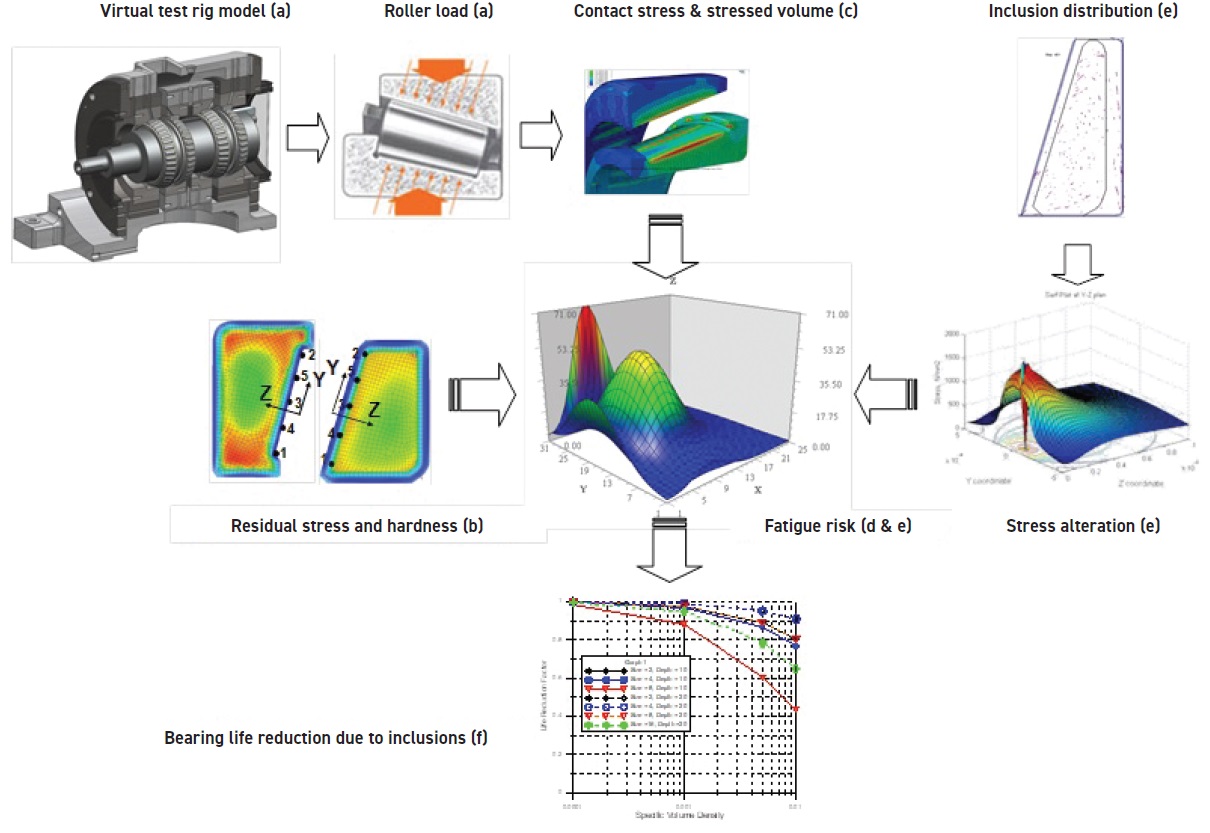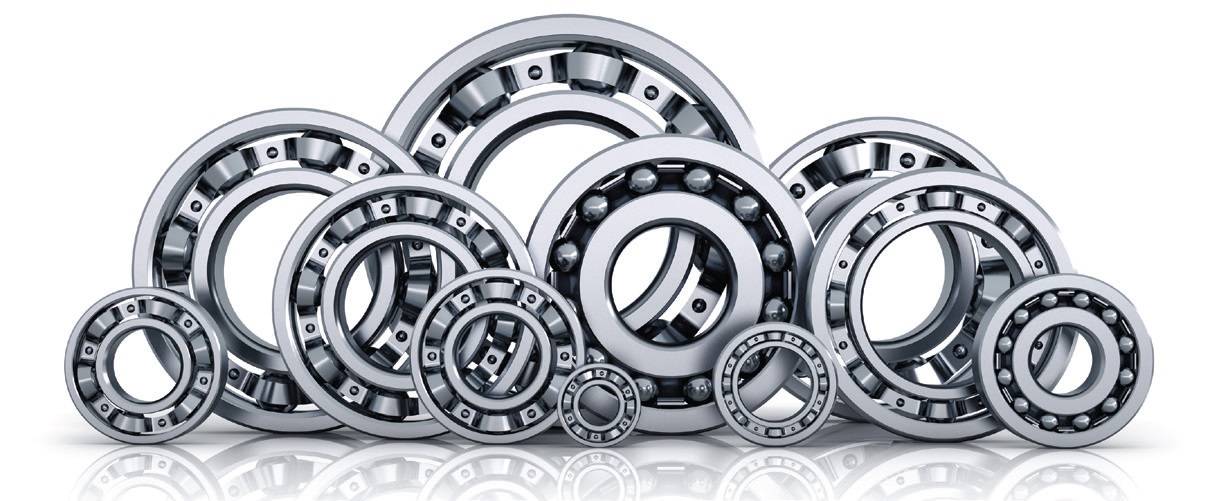TLT: Why is modeling such an important tool in bearing useful life prediction, and how does it work?
Ai: The damage mode of rolling element bearings varies widely. It depends on bearing design, manufacturing, handling, installation, maintenance and operating conditions. The ultimate damage mode, however, in a well-designed, quality-built, carefully maintained rolling element bearing is fatigue damage.
For the great majority of applications, rolling element bearings are selected based on their load ratings, which are closely associated with fatigue life performance. Thus, the ability to predict bearing fatigue life is of paramount importance. Physic testing played a very important role in establishing bearing ratings and an equally important role in product quality assurance.
Due to its statistical nature, bearing fatigue testing is a very time-consuming and costly exercise. It requires multiple bearings (usually 24 or more) with essentially identical attributes to be tested under the same load, speed and lubrication conditions. The test may last for several weeks or even months. As bearing size increases, the cost of physical testing quickly skyrockets. For large and ultra-large bearings, such as those used for the main shafts of wind turbines, physical bearing life testing is often cost prohibitive. This creates a pressing need to develop a means to conduct virtual bearing life testing (VBLT). An example of a VBLT model is shown in Figure 1. It can be viewed as a digital representation of an actual physical test where the test bearings and rig are modeled numerically through a layered structure to ensure the required resolution and computational efficiency. The model contains more than a dozen individual modules to describe various aspects of bearing performance attributes.
 Figure 1. VBLT model structure and computational work flow. (Copyright by ASME: A Comprehensive Model for Assessing the Impact of Steel Cleanliness on Bearing Performance,” by Xiaolan Ai, Journal of Tribol. 2014; 137(1).)
Figure 1. VBLT model structure and computational work flow. (Copyright by ASME: A Comprehensive Model for Assessing the Impact of Steel Cleanliness on Bearing Performance,” by Xiaolan Ai, Journal of Tribol. 2014; 137(1).)
VBLT starts with finite element (FE) modeling of the test rig from which the loads acting on each of bearings are obtained (
step a in Figure 1). Detailed FE models of the test bearings are built with a finer mesh grid where load distribution at the contacts between the rollers and raceways is estimated (
also step a). Roller loads are then passed on to a contact module where detailed contact analysis is performed for surface and subsurface stress distributions at each of the contact locations (
step c).
The model includes a heat treatment module to model the material’s response to different heat treatment processes. This module provides the resultant residual stress distributions and hardness profiles within the bearing components (
step b). A fatigue risk assessment module then combines the contact stresses and residual stresses to generate a critical stress, which is compared to the material strength to establish the risk of fatigue damage at the given point. The fatigue risk assessment module further integrates fatigue risk over the entire stressed volume of the material for all bearing components to derive an estimate of bearing life based on a three-parameter Weibull statistical distribution (
step d).
To consider the impact of surface roughness on bearing fatigue life, a rough contact module calculates contact stress fluctuations for a given load level using the measured 3D surface topography of the bearing raceway surfaces. An effective stress correction function is derived based on Miner's Rule of damage accumulation using the resulting stress fluctuations and is subsequently applied to the contact stresses of smooth surfaces subjected to the same load level.
Additional modules have been developed for calculating the stress alterations resulting from inclusions within the material or surface indentations on the bearing raceways. The inclusion module reads in inclusion information—including inclusion size, location, material property and orientation for every inclusion found within the bearing components—and calculates stress alterations within a super cell surrounding the inclusion.
The super cell is usually set at approximately 10 times larger in volume than the inclusion it encapsulates. The original stress field is then modified by substituting the super cells at their respective locations (
step e). The fatigue life of the bearing is re-evaluated using the modified stress field. A relative life with respect to nominal life can thus be obtained (
step f).
A similar methodology can be applied to the surface indentation module from which a life reduction factor due to the surface indentations is estimated for the dented bearings.
Through careful calibration with test data, VBLT, as a first principle-based model, can be extended to cover different bearing size and types, and to model different test conditions quickly with high fidelity. It not only provides an alternative to large and ultra-large bearing tests but also is a cost-effective means for conducting life tests on conventional sized bearings.
 © Can Stock Photo / scanrail
TLT: What are the main advantages and challenges in virtual bearing testing?
Ai:
© Can Stock Photo / scanrail
TLT: What are the main advantages and challenges in virtual bearing testing?
Ai: As mentioned, one of the main advantages is cost effectiveness. It allows application engineers anywhere to conduct bearing tests under various application scenarios quickly with minimum cost. In addition, it allows research and design engineers to conduct what-if studies to gain better insight into various factors that affect bearing life performance. This, in turn, could lead to improved bearing designs to achieve application objectives.
Bearing fatigue life modeling is by no means an easy task. The statistical nature of bearing fatigue indicates there are a host of influential variables that affect bearing life performance; some of them are still not yet fully understood or well controlled.
One of the challenges in bearing fatigue modeling is material microstructure response to stress cycles. To a certain extent, our current knowledge is still primarily experimental and phenomenon based. A unified damage mechanism across different material types and microstructures needs to be further explored. A computationally effective material response model applicable to all bearing steel material is yet to be established and validated.
TLT: What’s your view on the emerging powertrain technologies and their impacts in the next 10-15 years?
Ai: We are in an era of rapid change. We are currently at a converging point of several mega trends. Cyber-physical systems are a common theme across many industries. They call for product digitization, connectivity, intelligence and flexible automations. Concurrently, the automotive industry is experiencing a major transformation of electrification. This technical trend was originally driven by energy conservation and environmental concerns an more recently has been fueled by the rapid advancements in autonomous and artificial intelligence technologies. It is expected that the process of transformation will last for the next few decades. This transformation is also occurring in other mobile industries.
As we are embracing the new powertrain technologies and enjoy the many benefits they bring to society and end-users, we must also be prepared for the impact they bring upon manufacturing processes and component suppliers. For the bearings industry, this imposes challenges but also creates new opportunities. Bearings in electrified powertrains are required to operate at higher speeds and under thin lubricant film conditions to reduce friction and drag losses. Housing material, lubrication method and operating temperature also are expected to change. System noise, vibration and harshness (NVH) and thermal management become critically important.
To meet these challenges, rolling element bearings may need to be specifically engineered to attain the performance attributes of precision, quietness and higher fuel efficiency to support powertrain electrification. Design options for creating such products include bearing material cleanness, bearing macro- and micro-geometries, surface finishing and manufacturing process control. Bearing design engineers may need to push boundaries and establish new design practices to provide cost-effective solutions and competitive products.
TLT: What’s your current focus and interests?
Ai: Virtual bearing life testing, from a higher perspective, is a part of a digital engineering ecosystem. To support and be well prepared for the industry-wide digital revolution, we are currently looking at expending the horizon of virtual bearing life testing beyond fatigue—building a full virtual laboratory to include virtual tests of all performance attributes such as dynamics, noise and vibration, surface wear, scuffing, torque and heat generation for all types of rolling element bearings.
I am currently working closely with a group of talented colleagues toward this ambitious goal. Creating something new and useful has always been my passion, whether it's a piece of software, a product or a process.
You can reach Xiaolan Ai at xiaolan.ai@timken.com.